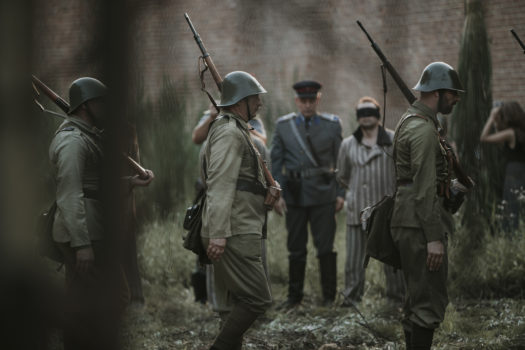
Between Pain and Amen
Director Toma Enache has used his second feature film “Between Pain and Amen” to tackle a story little known to many Westerners: about the brainwashing and torture-based experiment during the Communist party rule in the Pitești Prison Romania. Nobel Laureate and gulag survivor Alexander Solzhenitsyn called it “the most terrible act of barbarism in the contemporary world.
This gripping, fact-based drama portrays a young, talented composer, Tase Caraman, returning to Romania being arrested by the Communist regime and taken to a prison where torture led by the feared commander Ciumau. The barbaric experiment is conducted on the inmates in an attempt to “re-educate” them – to force them to lose all their previous political and religious convictions. Caraman’s strong will, faith and love for his fiancée Lia helps him survive.
Enache chooses to concentrate on the religious convictions which helped the protagonist to overcome the physical and mental torture.
On an important historical note, so far it has been the first and only film made on this important topic, which has been a taboo subject in Romania for many years. “Between Pain and Amen” is an independently produced production, made completely without government support. The director and the screenwriter consulted with the survivors during the making of the film.
The story is undeniably intriguing, as it merges the horrors of the Romanian communist regime with a gripping narrative about the incessant will to survive. It’s suspenseful and resonant, with an epic feel undeterred by its claustrophobic setting.
Enache handles the material well, and successfully avoids making the film’s impactful moments overwrought. The film does not depict graphically all the real life horrors which occurred, and has a poetic, lyrical tone in certain scenes. Romantic visuals of blooming fields accompanied by the protagonist playing beautiful music on his double bass, contrast with the gloomy prison interiors. Lead actors Ana Pârvu (Lia) and Vali V. Popescu (Tase), as well as Kira Hagi (Tana), have their feature film debut.
While the entire film is about a dark chapter in human history, it ends up being uplifting, as the film is a testament to the strength of the human spirit. One can only hope that the film helps to shed more light on the subject of the Pitești Prison experiment, not only in Romania, but globally.
From Pitesti prison, the experiment extended to other Romanian prisons. The people responsible for these atrocities were never punished. Most former prisons have been left in ruins or demolished and the deaths have never been investigated.
The film BETWEEN PAIN AND AMEN is the only feature film on this topic. It is an entirely independent production. The film premiered in Bucharest, on October 1st, 2019 and was completely sold out.
ABOUT THE DIRECTOR
Toma Enache was born on November 1, 1970 in the Black Sea city of Constanta, Romania. After five years of university studies he earned his bachelor’s degree at the Theatre and Film Academy in Bucharest (1998) and then his master’s in actor’s art at the same university. He has staged successful plays performed hundreds of times in Romania and abroad.
He made his debut in cinema with the film, I’M NOT FAMOUS BUT I’M AROMANIAN (2013), the first feature film in history spoken in the Aromanian/Vlach language. He then directed the documentary THE ARMANS/VLACHS, FROM THE FAMOUS MANAKIA TO I’M NOT FAMOUS, about the Manakia Brothers, of Aromanian/Vlach origin, the pioneers of the Balkan cinema, who shot the first scenes in the Balkans in 1905.
